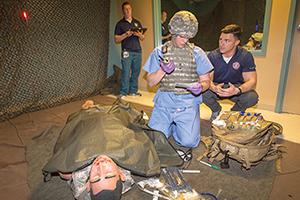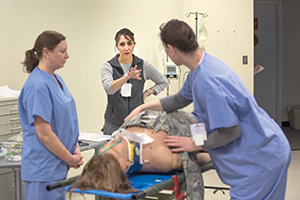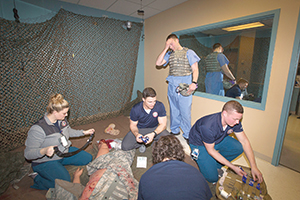By KATHLEEN NELSON
Photos by KAREN ELSHOUT
The fog of war wafts from a smoke machine. The sounds of gunfire blare from a recording. The dark of night comes from dimmed lighting. The victim is a male simulation mannequin who has lost his lower leg in an explosion.

Staff Sgt. Matthew Goebel, kneeling, an Air Force medic, checks a mannequin's vital signs during a training that simulates field trauma medicine in an active combat zone. Tech Sgt. Justin Williamson, Air Force medic and C-STARS instructor, answers questions as Goebel goes through a checklist in the Saint Louis University medical school's simulation laboratory in February. Tech Sgt. Brian Scheer, an Air Force medic and C-STARS trainer, observes.
The scene is set in a basement lab at the Saint Louis University School of Medicine. But to Staff Sgt. Matthew Goebel, a medic from Mountain Home, Idaho, this staging of the simulation known as tactical combat casualty care feels real.
Under the watchful eyes of four trainers, he applies a tourniquet to the injured leg, checks vital signs and covers the victim with a blanket. He asks questions of the victim, who is being voiced by a female trainer positioned in the observation room next door.
Goebel reacts to her responses, offering a drink of water along with reassurances to his patient and injecting pain medication to ease labored breathing. He checks with the trainers in the room to make sure he hasn't skipped a step, and calls for an evacuation vehicle.
After 15 minutes, he emerges from the room soaked in sweat, with a pat on the back from his trainers. And this was just the second day of a two-week training offered through C-STARS, the Center for Sustainment of Trauma and Readiness Skills. Together with the Saint Louis University School of Medicine, SSM Health Saint Louis University Hospital offers C-STARS 19 times a year in a partnership with the U.S. Air Force.
"It was great," says Goebel, who is scheduled to be deployed this spring. "This is a chance to put together all the skills you learn about but can only practice separately. You feel better prepared."
Skill sharpening
In addition to 15 hours of simulation training, C-STARS participants spend 16 hours in the classroom at SLU medical school and more than 60 hours assisting in the intensive care, emergency and surgery units of SSM Health Saint Louis University Hospital and SSM Health Cardinal Glennon Children's Hospital.
The training is offered to medical personnel who are members of the Air Force — active duty and reserve — and Air National Guard. Many complete C-STARS just before deployment in order to sharpen their trauma skills. The training staff consists of seven physicians on active duty, including trauma surgeons, general surgeons and anesthesiologists, as well as military nurses, medics and two respiratory therapists. C-STARS instructors work at the hospital under a training affiliation agreement between the Air Force and hospital.
Since the program's inception in 2003, more than 4,000 Air Force medical personnel have been through C-STARS in St. Louis, according to Maj. Adrienne Fields, the program's deputy director. "We see nurses, doctors, medics from around the country. Some have come from as far away as Germany and Japan," says Fields, a trauma nurse for 18 years, including 12 years in the Air Force.
Close parallels
The program began at SSM Health DePaul Hospital — St. Louis under Col. Michael E. Hayek, a retired flight surgeon who became medical director of trauma services at DePaul.

Air Force Major and Advanced Practice Nurse Adrienne Fields, center, leads nurses Lt. Lisa Roper, left, and Capt. Joanne Tremblay through a simulation of an emergency room triage of a stabbing victim. Tremblay is an Air Force officer and Roper is an officer in the Pennsylvania Air National Guard.
"During the Vietnam War, we developed what were cutting-edge practices, learning how to save lives in the field," says Helen Sandkuhl, administrative director of nursing for emergency, EMS, disaster and clinical outreach services at Saint Louis University Hospital. "Years passed, budgets were cut, and a lot of our military medical staff didn't have a chance to (practice) clinical trauma skills."
Recognizing that, Hayek reached out to the Department of Defense to create a program that integrated civilian and military medical staff who could learn from each other and share best practices in trauma care. Following Hayek's death, the program moved to Saint Louis University Hospital, which is one of three C-STARS training centers for the Air Force, along with the University of Maryland School of Medicine and Medical Center in Baltimore and University of Cincinnati Medical Center. Each was chosen because of the high number of trauma cases it treats.
Fields notes that Saint Louis University Hospital, a Level 1 trauma center, treats a high number of patients with knife and gunshot wounds. Those penetrating, life-threatening injuries are "the closest to what you see downrange," military slang for deployment in a combat zone.

Goebel wipes his brow after finishing a field simulation where he stabilized a patient who lost a portion of his leg in a combat explosion. C-STARS instructors Williamson, center, and Scheer, right, wrap up the scene with the help of Master Sgt. Emily Green, left, and Tech Sgt. Kristin Owensby, foreground. Both Green and Owensby are C-STARS instructors and active duty Air Force medics.
The youngest casualties
While Goebel works in the simulated battle zone, Fields works in a simulated emergency room with Capt. Joanne Tremblay and Lt. Lisa Roper, both nurses, triaging and treating a mannequin for stab wounds. Tremblay is stationed at Travis Air Force Base in central California. Roper is a member of the Air National Guard's terrorist activity response unit based in Harrisburg, Pa. Fields guides the two through a checklist, making them double back if they miss a step.
"This is really going to help us because of what we'll see here at a Level 1 trauma center," says Tremblay, who is scheduled to be deployed this spring. "When you're in the heat of things, you can get that deer-in-the-headlights feeling. They're training us to get over that."
Tremblay says she was especially eager for her rotation at Cardinal Glennon Children's Hospital.
Rotations at Cardinal Glennon are a response to medical staff who have been deployed in combat areas and reported a need to be better prepared to treat "kids in the cross fire — they have to take care of in burn units or ICU," Saint Louis University Hospital's Sandkuhl says. "That was something they underestimated, and we're very fortunate to have Cardinal Glennon to include in our C-STARS training."
Two-way learnings
While Air Force staff handle much of the mannequin simulation training — "you have to be a genius to make them operate properly," Sandkuhl says — C-STARS participants spend the bulk of the program working side-by-side with staff from Cardinal Glennon and Saint Louis University Hospital on rotations in intensive care units, trauma surgery and emergency departments. Among the C-STARS trainers at Saint Louis University Hospital is Maj. Matthew Pieper, a trauma surgeon who has been deployed several times.
"If you're coming from a place where you're not seeing trauma patients, the training can be a big benefit," says Pieper, who has trained C-STARS participants for four years. "They get exposed to several resuscitations, ICU, trauma surgery and acute care surgery."
Before joining the Saint Louis University Hospital staff, Pieper underwent C-STARS training in Cincinnati. He says he prefers the adjustments the St. Louis hospital has made to tailor the program. "I didn't get as much patient interaction in my training," he says. "We offer a better mix of patient and simulation encounters."
Sandkuhl adds, "This is the best of both worlds, being able to train the military while having a lot of extra hands in our trauma departments. The military has brought its own brand of professionalism to the program. It's been a learning experience for both sides."
Copyright © 2018 by the Catholic Health Association
of the United States
For reprint permission, contact Betty Crosby or call (314) 253-3490.